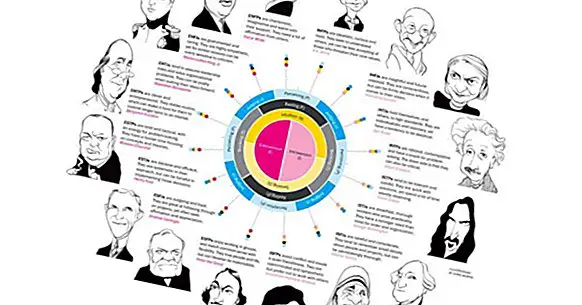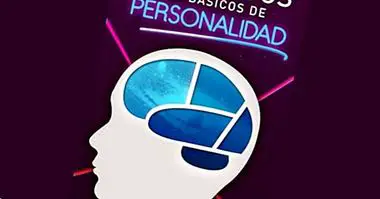The 16 personality types (and their characteristics)
The Myers-Briggs indicator is one of the most popular personality tests of today, among other things, for the ambitious of its proposal.
Unlike what happens with other instruments of personality measurement, which measure very specific aspects of our behavior and thought patterns, the Myers-Briggs Indicator was developed to explore the most important and unique aspects that would serve to describe the way of being of each individual through 16 personality types.
The latter means that the Myers-Briggs indicator was made with the will to describe the personality globally, instead of making measurements on very specific aspects of the way people are. This idea, based on what is usually known as "holistic" approaches, is very attractive for many people who see this personality test a way to know the essentials of people, what defines them in a more complete sense .
However, today the Myers-Briggs Indicator has critics who point to the validity and usefulness of the test and, consequently, of the 16 personality types it proposes. Let's see what the defense is based on and the negative criticism of this system of classification of personalities.
What is the Myers-Briggs Indicator?
The MBTI, as it is known in English, is a personality test based on the works of Carl Gustav Jung and the personality types he proposed.
The Myers-Briggs Indicator borrows 8 of the psychological functions that Jung used to theorize about different personality types and proposes a system of questions that serve to study the way in which the preferences and the way of being of the people conform to these categories.
If you want to know more about these ideas of Carl Jung, you can read this article:
- The 8 personality types according to Carl Gustav Jung
How does the MBTI work?
The Myers-Briggs Indicator uses four dichotomies with two ends each to study personality. These factors are the following:
- Extraversion (E) or Intraversion (I)
- Intuition (N) or Sensation (S)
- Thought (T) or Feeling (F)
- Judgment (J) or Perception (P)
Each person responds to the questions that are posed in the test by reflecting on their way of being, thinking and feeling, which makes this a measurement tool based on introspection. From these answers, the obtained data are grouped and in this way it is established which of the 16 personality types It serves to better describe the way of being and the preferences of oneself.

The 16 personality types
From the data crossing of these 8 variables established in the 4 dichotomies, the 16 personality types of the Myers-Briggs Indicator are formulated. They are the following.
1. ESTJ (Extraverted Sensing Thinking Judging)
People who like to have control over what happens around them , they always look for the way that everything works as it should and, if necessary, they implement it themselves.
2. ESTP ((Extraverted Sensing Thinking Perceiving)
People who belong to this category are spontaneous, cheerful and active , but like what happens with the ESTJ, they tend to exercise dominion over others, in this case through their capacity for observation and their charisma.
3. ESFJ (Extraverted Sensing Feeling Judging)
These are people who are very focused on caring for the needs of others , especially if they are part of your close circle: family and friends. That is why whenever they can lend their help and ensure that their close social circles remain always stable and in good health. That is why they tend to avoid strong conflicts and show diplomatic when there are clashes of interests.
4. ESFP (Extraverted Sensing Feeling Perceiving)
They are happy and spontaneous people who enjoy entertaining and entertaining others . Fun is one of the most important pillars of their lives, and they are of close treatment and warm temperament. They love novelty and talk about personal experiences.
5. ISTJ (Introverted Sensing Thinking Perceiving)
A personality type defined by its strong sense of morality and duty . They like to plan and implement systems of rules that allow teams and organizations to work with clear logic and order. They give great value to the rules and to the need for reality to correspond with how things should be. Although they are introverted people, they do not shy away from interacting with others.
6. ISTP (Introverted Sensing Thinking Perceiving)
These are reserved people, oriented to action and practical solutions to day-to-day problems . They are also defined by their tendency towards logical thinking and its spontaneity and autonomy. They like to explore environments and discover ways in which they can interact with them.
7ISFJ (Introverted Sensing Feeling Judging)
They are people defined mainly by their desire to protect and help others and, in short, to be reliable for others. They strive to do everything that is expected of them, but do not have great aspirations or are very ambitious. They tend to think that it is wrong to ask for compensations or increases in exchange for the sacrifices they make when it comes to work, since this should be a goal in itself.
8. ISFP (Introverted Sensing Feeling Perceiving)
People who live totally in the here and now, in constant search for novelty and sensorially stimulating situations . They are reserved, but also cheerful, spontaneous and warm with their friends. They have a special talent in the world of arts.
9. ENTJ (Extraverted Intuitive Thinking Judging)
This is one of the 16 personality types most related to leadership and assertiveness . The people described by this category are communicative, agile and analytical thinking and predisposed to lead teams and organizations. They adapt well to change and make their strategies adapt as well whenever the environment changes. In addition, they almost always know how to explain their projects or stories in ways that are of interest to the rest, which makes them very apt commercials.
10. ENTP (Extraverted Intuitive Thinking Perceiving)
People especially moved by curiosity and challenges that to be resolved require facing intellectually stimulating questions. Their mental agility and their ability to detect logical inconsistencies make them predisposed to be interested in science or philosophy. In addition, their tendency to be competitive makes them very active during the day, always trying to reach innovative solutions to complex problems.
11. ENFJ (Extraverted Intuitive Feeling Judging)
People who constantly learn about all areas of knowledge (or a good part of them) and help to learn the others, guiding them in their own evolution. They like to offer tutelage and advice, and they are very good at influencing the behavior of others. They focus on their values and ideals and do their best to improve the welfare of the greatest number of people through their ideas and actions.
12. ENFP (Extraverted Intuitive Feeling Perceiving)
One of the 16 personality types with the greatest propensity to creative thinking, the arts and sociability. They are happy, enjoy interaction with other people, and act with their position in mind as part of an "all" formed by humanity, and do not show individualism. In fact, they usually get involved in collective tasks to help others, thinking about the social impact of their actions. However, they are also easily distracted and often postpone tasks that they consider boring or too simple and routine.
13. INTJ (Introverted Intuitive Thinking Judging)
A personality type oriented towards solving specific problems based on analytical reasoning . The ones described by this category are people who are very focused on their own ideas and theories about the functioning of the world, which means that they analyze their surroundings focusing on their ideas about how this works. They are aware of their own abilities and trust their own criteria, even if this goes against some superiors.
It is very common for them to become experts in a very specific field of knowledge, since they like to have enough knowledge about something to be able to take into account all the factors that come into play in their functioning and, from there, to know what can be done or what will happen in the future.
14. INTP (Introverted Intuitive Thinking Perceiving)
One of the 16 personality types most defined by the propensity to reflect . These people like the theories with the ability to explain everything that can happen in a system, and their tendency towards perfectionism makes them correct others on multiple occasions. They value accuracy more in theoretical terms than pragmatism and the resolution of concrete problems.
15. INFJ (Introverted Intuitive Feeling Judging)
Very sensitive people, reserved and moved by very defined ideals In addition, they feel the need to make others also benefit from these ideals. This makes them prone to both reflection and action, which can amount to so much work that they are overburdened by having too many responsibilities. They show a great ability to successfully interpret the mental states of others and try to use this information to help them before the other person asks for it.
16. INFP (Introverted Intuitive Feeling Perceiving)
Less moralistic than the INFJ, the INFP also care a lot about helping others from his position as reserved people. They show an aesthetic and artistic sensibility that makes them creative.
Criticisms of the Myers-Briggs Indicator
There are many researchers and academics who deny the idea that the MBTI has any value for science, basically based on ideas (those of Carl Jung) that were not born through the use of the scientific method and because, in addition, consider that the 16 personality types are too ambiguous and abstract as to be able to be used to predict patterns of thought or behavior.
That is, any person could read the descriptions of these personality categories and see themselves reflected in many of them at the same time, because they are so general. This phenomenon is an example of the Forer effect, according to which when the personality categories are sufficiently ambiguous, anyone can identify with them to the point of believing that they fit well to their way of being and not to others. In turn, this is a case of confirmation bias.
So ... is not it useful?
The problem of the ambiguity of the personality categories with which the Myers-Briggs indicator works also occurs in a similar way, for example, in Carl Jung's personality proposal. It is assumed that a personality model has to lay the foundations to isolate relevant psychological variables and that in certain investigations tangan a certain predictive value (That is, to clear up doubts about what is going to happen, for example, if a person with high levels of neuroticism begins to work in an environment facing the public and with a lot of pressure.
When the popularity of a personality model is based on the Forer effect, we must expect little of its usefulness as a research tool, because everyone is able to feel identified by practically any personality type and the final result will depend on little factors important, such as the description of personality style that is read before, for example.
That is why, although the Myers-Briggs Indicator is still used in organizational contexts to select personnel or assess the possibility of someone ascending, in the field of research this tool has been so harshly criticized that its use is a rarity.
Now, that does not mean that, in its own way, there may be certain utilities for the Myers-Briggs indicator. For example, the possibility of inspiring ourselves, making us reflect on how our personality is structured and how these aspects of personality relate to each other.



















